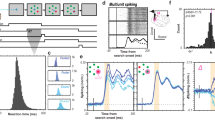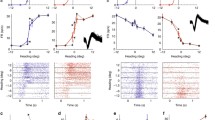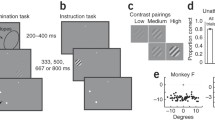Summary
In the awake, behaving cat, we have compared response of striate cortex neurons to informative and to noninformative stimuli. A cat pressed a pedal in response to a flashed pattern repeated every 10 s, receiving a reward if the press was within a 0.5–1.5-s post-stimulus window. There were three trial types: 50% of the trials had only the initial informative flash, 25% had an additional physically identical, but unrewarded, flash 500 ms after the first, and 25% had an unrewarded flash 3–5 s after the informative flash. Cats learned to respond only to the rewarded flashes. Neurons were divided into two categories: 27 neurons defined as “primary” showed an early burst of firing 30–70 ms after stimulus onset, and 17 did not. The distinction was arbitrary, since all cells were exposed to the same stimulus. For stimuli preceding a pedal press, stimulus-synchronized histograms of primary neurons had a smaller early burst and more firing before and after it. Response-synchronized histograms showed an abrupt decrease in firing shortly before the pedal press. The effects were stronger for primary cells in the stimulus-synchronized data and stronger for non-primary cells in the response-synchronized data.
Similar content being viewed by others
References
Bridgeman, B. (1972). A simple system for extracellular microelectrode recording from awake animals. Electroencephalogr Clin Neurophysiol, 33, 116–118.
Bridgeman, B. (1980). Temporal Response Characteristics of Cells in Monkey Striate Cortex Measured with Metacontrast Masking and Brightness Discrimination. Brain Research, 196, 347–364.
Bridgeman, B. (1982). Multiplexing in single cells of the alert monkey's visual cortex during brightness discrimination. Neuropsychologia, 20, 33–42.
Bridgeman, B. (1986). Relations between the physiology of attention and the physiology of consciousness. Psychol Res, 48, 259–266.
Haenny, P. E., & Schiller, P. H. (1983). The behavioral significance of visual stimuli infuences the responses of single cells in V1. Invest Ophthalmol Vis Sci, 24, 106.
Haenny, P. E., & Schiller, P. H. (1988) State dependent activity in monkey visual cortex. I. Single cell activity in V1 and V4 on visual tasks. Exp Brain Res 69, 225–244.
Moran, J., & Desimone, R. (1985). Selective attention gates visual processing in the extrastriate cortex, Science 229, 782–784.
Wurtz, R. H., & Mohler, C. W. (1976a). Organization of monkey superior colliculus: enhanced visual response of superficial layer cells. J Neurophysiol 39, 745–765.
Wurtz, R. H., and Mohler, C. W. (1976b). Enhancement of visual responses in monkey striate cortex and frontal eye fields. J Neurophysiol 39, 766–772.
Author information
Authors and Affiliations
Rights and permissions
About this article
Cite this article
Artim, J., Bridgeman, B. The physiology of attention: participation of cat striate cortex in behavioral choice. Psychol. Res 50, 223–228 (1989). https://doi.org/10.1007/BF00309256
Received:
Issue Date:
DOI: https://doi.org/10.1007/BF00309256




